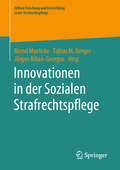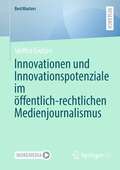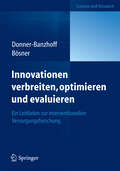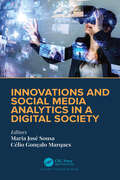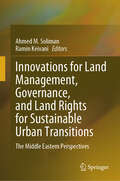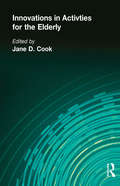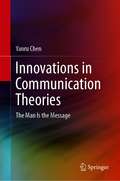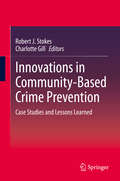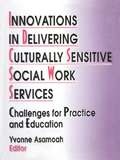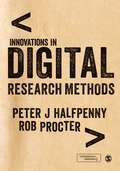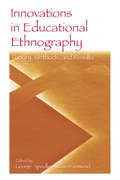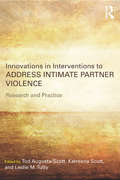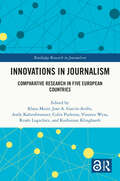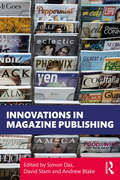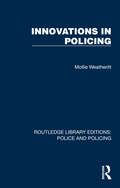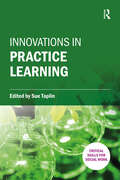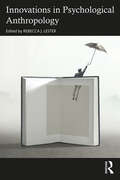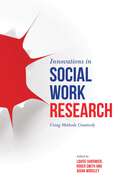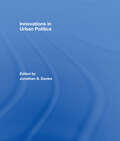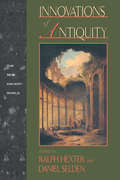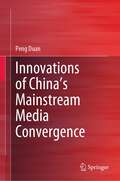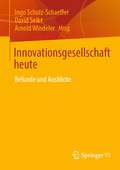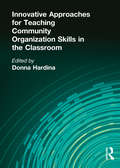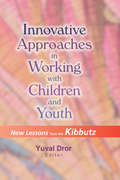- Table View
- List View
Innovationen in der Sozialen Strafrechtspflege (Edition Forschung und Entwicklung in der Strafrechtspflege)
by Bernd Maelicke Tobias M. Berger Jürgen Kilian-GeorgusIn diesem Band 2 der Edition „Forschung und Entwicklung in der Strafrechtspflege“ entfalten und vertiefen die Autoren das Konzept der Sozialen Strafrechtspflege und analysieren die Stärken und Schwächen der Umsetzung in die Praxis der Strafverfolgung und Strafvollstreckung – sowohl auf der Ebene des Einzelfalls als auch des Managements und der Systementwicklung. In einem weiteren Schwerpunkt werden Innovationsstrategien dargelegt und erfolgreiche Innovationsprojekte präsentiert. Ein Ausblick entwickelt eine Agenda für wirksame und nachhaltige Aktivitäten in den nächsten Jahren und Jahrzehnten.
Innovationen und Innovationspotenziale im öffentlich-rechtlichen Medienjournalismus (BestMasters)
by Steffen GrütjenDer Medienjournalismus als fachjournalistische Disziplin ist landläufig mit einem Nischenstempel behaftet. Seit seinen Anfängen als klassische Medienseite in (überregionalen) Tageszeitungen hat er sich stark ausdifferenziert und tritt mit neuen Angebotsformen inzwischen verstärkt im Social Web auf. Die Forschungsarbeit systematisiert und reflektiert erstmals Innovationsstrukturen im öffentlich-rechtlichen Medienjournalismus. In Leitfadeninterviews gewähren Medienjournalist*innen von ARD und Deutschlandradio Einblicke in ihre (innovative) Programmgestaltung und formateigenen Zielgruppenvorstellungen. Als Forschungsgegenstand werden neun genuine Medienmagazine betrachtet, darunter „ZAPP“ (Norddeutscher Rundfunk), „@mediasres“ (Deutschlandfunk) oder „Töne, Texte, Bilder“ (Westdeutscher Rundfunk). Mit Blick auf den öffentlich-rechtlichen Auftrag messen die Befragten dem Medienjournalismus in öffentlich-rechtlicher Verantwortung eine große Bedeutung bei – sowohl im Lichte einer kritischenBegleitung von journalismus- bzw. medienspezifischen Themen und Spannungsfeldern als auch bei der Wandelbarkeit von tradierten Programmmustern.
Innovationen verbreiten, optimieren und evaluieren
by Norbert Donner-Banzhoff Stefan BösnerDas Buch richtet sich an Wissenschaftler, die sich mit dem noch relativ jungen medizinischen Feld der Versorgungsforschung beschäftigen. Der Leser findet eine gut verständliche und nachvollziehbare Anleitung, um erste eigene Schritte zu gehen. Und der geübte Versorgungsforscher kann das fundierte und durch die reichhaltige Projektarbeit der Autoren reflektierte Wissen nutzen, um neue Ideen zu entwickeln. Methodische Überlegungen zu qualitativen und quantitativen Verfahren werden von zahlreichen Beispielen unterlegt, die es dem Leser erlauben, ein eigenes Vorsorgungsforschungsprojekt zu konzipieren und durchzuführen. Hierbei sprechen die Autoren mögliche Fallstricke auf dem Weg an und ermutigen den Leser, sich auch noch auf der Zielgeraden eine gesunde Portion Selbstkritik zu bewahren. Gute Versorgungsforschung ist wegen der komplexen Materie eben kein leichtes, aber ein durchaus lohnendes Unterfangen.
Innovations and Social Media Analytics in a Digital Society
by Maria José Sousa and Célio Gonçalo MarquesRecent advances in digitization are transforming healthcare, education, tourism, information technology, and some other sectors. Social media analytics are tools that can be used to measure innovation and the relation of the companies with the citizens. This book comprises state-ofthe-art social media analytics, and advanced innovation policies in the digitization of society. The number of applications that can be used to create and analyze social media analytics generates large amounts of data called big data, including measures of the use of the technologies to develop or to use new services to improve the quality of life of the citizens. Digitization has applications in fields from remote monitoring to smart sensors and other devices. Integration generates data that need to be analyzed and visualized in an easy and clear way, that will be some of the proposals of the researchers present in this book. This volume offers valuable insights to researchers on how to design innovative digital analytics systems and how to improve information delivery remotely.
Innovations for Land Management, Governance, and Land Rights for Sustainable Urban Transitions: The Middle Eastern Perspectives
by Ramin Keivani Ahmed M. SolimanThe transformation of the built environment during the last few decades has placed enormous demands for land. About 7.7 billion people live on the planet, which is expected to increase by 2.5-3.0 billion in just 30 years, with the highest growth projected to be in less developed regions. The spreading of urban informality in cities of the Global South leads to chaotic informal economies and an inability to capitalize on urban-rural economies of scale and exchange. The combination of socioeconomic and climate change vulnerability in urban centres is having a “double impact” on already poverty-stricken and marginalized groups (especially women, racialized, and ethnic minority groups) – leading to what has come to be known as “climate injustice”. Land constitutes a main component of urban development and is the main asset for informal urban communities in the Middle East region. The State and urban planners can aim to regulate the growth of informal land markets or represent the interests of the citizens. However, in reality the increasing retreat or absence of the public authorities, the crisis of confidence between the governed and governing, and the deficit of urban policies to address the multitude of generated challenges cannot be concealed. This volume examines three main themes: land management and governance in the era of sustainability; Legal, informal, and illegal land tenures; and the broader socioeconomic changes impacting land (and housing) delivery. It investigates the correlations, transitions, and interactions between the various forces and multi-stakeholders that control and adjust the land delivery system for low-income groups and the urban poor. This includes exploring mechanisms for correcting urban inequalities between central and peripheral quarters and the modes of shared governance. Finally, the volume also discusses developing national land policies based on legal instruments that connect the implementation of the SDGs, land, and tenure security as critical drivers for more sustainable land delivery realization.
Innovations in Activities for the Elderly: Proceedings of the National Association of Activity Professionals Convention
by David CookConcrete directions for programming and reasons for developing and refining such programs.
Innovations in Communication Theories: The Man Is the Message
by Yanru ChenThis book offers a novel approach to innovations in theories of communication and social development. It proposes that "the man is the message". It argues that communication is woven into the fabric of people’s daily lives, and a scholar with a keen eye, an open heart and an inquiring mind should be able to capture the ubiquitous phenomena of communication and turn them into theoretical observations and even innovations.Although most of the propositions in this book cannot be tested empirically, at least for now, owing to the limitations inherent in current research methods, they complement the empirical studies of communication based on measurement.With due understanding that Western social sciences, including communication studies, focus on analytical thinking and the fine division of disciplines, this book takes a more synthetic approach to analyzing communication, often integrating and contextualizing its various factors and channels and categories in analysis and writing. Providing a holistic picture of communication that features the crux of the matter—how to reach and capture the heart and soul of people without any attempt to manipulate their minds, it is more humanistic than many other books on communication studies. Although much of the thinking in the book is seemingly Chinese, it nevertheless has a universal appeal.
Innovations in Community-Based Crime Prevention: Case Studies and Lessons Learned
by Charlotte Gill Robert J. StokesThis book explores multi-year community-based crime prevention initiatives in the United States, from their design and implementation, through 5-year follow ups. It provides an overview of programs of various sizes, affecting diverse communities from urban to rural environments, larger and smaller populations, with a range of site-specific problems. The research is based on a United States federally-funded program called the Byrne Criminal Justice Initiative (BJCI) which began in 2012, and has funded programs in 65 communities, across 28 states and 61 cities. This book serves to document the process, challenges, and lessons learned from the design and implementation of this innovative program. It covers researcher-practitioner partnerships, crime prevention planning processes, programming implementation, and issues related to sustainability of community-policing initiatives that transcend institutional barriers and leadership turnover. Through researcher partnerships at each site, it provides a rich dataset for understanding and comparing the social and economic problems that contribute to criminality, as well as the conditions where prosocial behavior and collective efficacy thrive. It also examines the future of this federally-funded program going forward in a new Presidential administration. This work will be of interest to researchers in criminology and criminal justice, particularly with an interest in translational/applied criminology and crime prevention, as well as related fields such as public policy, urban planning, and sociology.
Innovations in Delivering Culturally Sensitive Social Work Services: Challenges for Practice and Education
by Yvonne AsamoahInnovations in Delivering Culturally Sensitive Social Work Services: Challenges for Practice and Education is for human service professionals and educators who are seeking innovative ways to make their practice and service delivery more culturally appropriate and their education and training more relevant. As Editor Yvonne Asamoah explains, “There has never been a more critical time for social work practitioners, educators, and policy makers to critique their programs, service delivery systems, and curricula for cultural relevance. Apart from federal and state mandates which require agencies to demonstrate how they are preparing workers to deliver culturally sensitive services, demographic shifts and increasing economic hardships are continually producing a more diverse clientele in need of service. . . . Being sensitive to the needs of the local community and the subtle, but significant, ethnic differences within them is critical and has important implications for training, policy, and practice.”The contributors describe actual models put into practice in the U.S. and Canada--analyzing the results and debating the issues of diversity and cultural sensitivity in regard to the social work profession. Innovations in Delivering Culturally Sensitive Social Work Services gives you an inside look at different approaches, programs, and studies, including: an innovative demonstration project designed to deliver social services to people from different cultures in Canada an eight-step communication process model that social work agency supervisors and training units may use to help workers become more effective multicultural practitioners a study on the incidents of misunderstanding between social workers from a Western-oriented society and those from a non-Western society in terms of culture shock the results of a statewide survey in Nevada on attitudes of social workers in relation to diversity, using a modified Multicultural Counseling Inventory to measure awareness, knowledge, and skills the four major multicultural issues considered critical to the delivery of health and mental health, and preventative and treatment services to Latino clients an examination of the issue of diversity in the workplace using the university and schools of social work as examplesOther important contributions in Innovations in Delivering Culturally Sensitive Social Work Services include a unique look at the topic of cultural diversity and sensitivity from a management perspective--introducing you to the concept of the ‘globally aware’social work manager. Practical suggestions to assist you in achieving global awareness are provided through a “Global Problem Analysis Worksheet” including issues of staffing, hiring and retention of foreign born staff; service planning and organization to meet the needs of immigrants, refugees, and other international populations; staff development; and broader organizational concerns of information systems and policymaking. Two other chapters directly relate to the critical issues raised by Paige in his comprehensive 1986 work on cross-cultural orientation and applications. These chapters will help you view your own cross-cultural encounters with both clients and peers in a broader, theoretical context.
Innovations in Digital Research Methods
by Rob Procter Peter HalfpennyVast amounts of digital data are now generated daily by people as they go about their lives, yet social researchers are struggling to exploit it. At the same time, the challenges faced by society in the 21st century are growing ever more complex, and demands research that is bigger in scale, more collaborative and multi-disciplinary than ever before. This cutting-edge volume provides an accessible introduction to innovative digital social research tools and methods that harness this ‘data deluge’ and successfully tackle key research challenges. Contributions from leading international researchers cover topics such as: Qualitative, quantitative and mixed methods research Data management Social media and social network analysis Modeling and simulation Survey methods Visualizing social data Ethics and e-research The future of social research in the digital age This vibrant introduction to innovative digital research methods is essential reading for anyone conducting social research today.
Innovations in Digital Research Methods
by Rob Procter Professor Peter HalfpennyVast amounts of digital data are now generated daily by people as they go about their lives, yet social researchers are struggling to exploit it. At the same time, the challenges faced by society in the 21st century are growing ever more complex, and demands research that is bigger in scale, more collaborative and multi-disciplinary than ever before. This cutting-edge volume provides an accessible introduction to innovative digital social research tools and methods that harness this ‘data deluge’ and successfully tackle key research challenges. Contributions from leading international researchers cover topics such as: Qualitative, quantitative and mixed methods research Data management Social media and social network analysis Modeling and simulation Survey methods Visualizing social data Ethics and e-research The future of social research in the digital age This vibrant introduction to innovative digital research methods is essential reading for anyone conducting social research today.
Innovations in Educational Ethnography: Theories, Methods, and Results
by George Spindler Lorie HammondThis volume focuses on and exemplifies how ethnography--a research tool devoted to looking at human interaction as a cultural process rather than individual psychology--can shed light on educational processes framed by the complex, internationalized societies in which we live today. Part I offers theoretical chapters about ethnography and examples of innovative ethnography from particular perspectives. In Part II, the emphasis is on the application of ethnographic approaches to educational settings.Each contribution not only takes the reader on a thoughtful and enlightening journey, but raises issues that are important to both educators and ethnographers, including the relationship of researcher to subject, the meaning of "participant" in participant observation, and ways to give voice to disenfranchised players, and on the complex ways in which all parties experience identities such as "race" in the modern world.Innovations in Educational Ethnography: Theory, Methods, and Results is a product of both continuity and change. It presents current writings from mentors in the field of ethnography and education, as well of the work of their students, and of educators engaged in cultural studies of their work. In many ways it provides fresh, new vistas on the old questions that have always guided ethnographic research, and can be used as a survey both of what ethnography has been and what it is becoming.This book is the work of many hands, and provides excellent examples of trends in both basic and applied ethnography of education. These two kinds of work augment and reinforce each other, and also represent important current research directions--in-depth reflection on the process of ethnography itself, and an application of its insights to teaching and learning in schools, universities, and communities. No one philosophy guides the contributions to this volume, nor were they chosen as exemplary of a particular approach, yet foundational understandings and principles of ethnography shine through the work, in both predictable and unexpected ways.
Innovations in Interventions to Address Intimate Partner Violence: Research and Practice
by Tod Augusta-Scott Katreena Scott Leslie M. TuttyInnovations in Interventions to Address Intimate Partner Violence: Research and Practice speaks to what can be done to effectively intervene to end intimate partner violence against women. Including contributions from both researchers and practitioners, chapters describe service innovations across systems in large urban and remote rural contexts, aimed at majority and minority populations, and that utilize a range of theoretical perspectives to understand and promote change in violence and victimization. Reflecting this range, contributions to this volume are organized into five sections: legal responses to domestic violence, intervention with men who have perpetrated domestic violence, responses to women who have experienced domestic violence, restorative approaches to intimate partner violence, and a section on integrating intervention for domestic violence across systems. The book highlights advances in practice which will be of interest to researchers, practitioners, policy makers and students.
Innovations in Journalism: Comparative Research in Five European Countries (Routledge Research in Journalism)
by Klaus Meier Vinzenz Wyss Jose A. García-Avilés Andy Kaltenbrunner Colin Porlezza Renée Lugschitz Korbinian KlinghardtThis volume explores innovations in journalism: the goals and expectations associated with them, promoting and hindering framework conditions, and their social and industrial impact.Drawing on an international research project conducted in Germany, Austria, Switzerland, Spain, and the United Kingdom, the book takes a complex approach, considering media policy preconditions and the social impact of journalistic innovation from a comparative perspective. The key findings are examined and presented on different levels: theoretical, methodological, and – as the focus – empirical.Having identified the most relevant innovations in each of the five countries, a total of 100 case studies are examined to explore the influence of these innovations on the quality of journalism and its normative role in democratic societies and to analyze which preconditions support or inhibit the development and implementation of the innovations in news organizations. The interdependencies between journalistic innovations and their media policy preconditions are compared in a system-analytical way – concluding with the lessons that can be learned from the macrolevel (policies) and the mesolevel (organizations).This insightful and truly international volume will interest professionals, scholars and students of journalism, media and communication studies, media industry studies, and related fields.
Innovations in Magazine Publishing
by Simon DasThis book examines the key developments in the UK magazine industry since 2014 and explains in detail how the business has innovated to survive. Innovations in Magazine Publishing explores the key issues that publishers and editors have had to grapple with in recent years and demonstrates how they have changed their business models and encouraged innovation and creativity. Written in an engaging and accessible style, the authors and contributors have drawn on years of industry expertise and contacts to examine the massive changes that have taken place in the areas of content creation and advertising in the last decade. Beginning with a highly useful summary of UK magazine publishing history, the book then provides a detailed focus on how magazines have had to adapt to a declining revenue picture in both copy and advertisement sales. This discussion considers changes in ownership and the supply chain, mutual dependency on social media, the rapid growth of the independent sector, investing in brand and product extensions, and how media companies themselves have changed to meet the demands of the new era. The important issue of ethnic diversity within the UK publishing industry is addressed and the introduction also includes a discussion of the effects of the Covid-19 pandemic on the industry, and how the magazine business will need to respond to whatever the future may bring. This comprehensive overview of the current state of the industry is a vital resource for students, researchers and professionals in magazine journalism, as well as for those studying media and journalism studies more generally.
Innovations in Policing (Routledge Library Editions: Police and Policing)
by Mollie WeatherittModern police forces are large and complex organisations, expected to perform a diversity of tasks and are under pressure to account for their activities in ways which satisfy a variety of constituencies. Originally published in 1986, this book documents some of the changing demands and pressures on the police at the time. It shows how the police were responding and assesses the extent to which they were open-minded and receptive to change. The book brings together in one place and critically reviews information on a considerable number of police operational and management initiatives. It describes and assesses recent innovations and experiments in two main areas: patrol and crime prevention. It describes attempts to make the police more efficient and effective and to measure the results of what they do. It documents the interest of central government in what the police do and shows how this can affect police operational priorities. Throughout, this book is concerned to analyse police practice and attitudes and to set them against a wider background of pressures to improve police effectiveness.
Innovations in Practice Learning (Critical Skills for Social Work)
by Sue TaplinAs a social work practice educator and trainer, it is useful to seek advice from more experienced colleagues who could help you find ways to overcome difficulties you may encounter in supporting individual students. This book is a handy companion for those times when a colleague is not readily available.The editor, Sue Taplin, chose these contributors for their practice wisdom and because she knew that, from their own experience, they had developed innovative practice that you can adapt to find your own solutions to the problems that you face. The contributors can be said to be experts by experience in their chosen field, some are practitioners, some are academics, but all have faced difficulties in the real world of practice learning and have been generous enough to offer to contribute a chapter to this edited textbook.
Innovations in Psychological Anthropology
by Rebecca J. LesterThis volume offers a bold and long-overdue intervention into the field of psychological anthropology. It asks how scholars might both constructively destabilize old frameworks borne from the field’s complex past and seed innovative new engagements in order to chart ethical, responsible, and constructive ways forward. The contributions cover such topics as white supremacy and the production of knowledge, new perspectives on the “disabled” mind, the importance of ethnographic refusal, silence in narrative, and the racialization of therapeutic methods. This timely book seeks to reinvigorate the field and lay groundwork for a new bridge between the subdiscipline and the wider anthropological community. It is an ideal text for courses in anthropology, psychology, and the wider social sciences and humanities.
Innovations in Social Work Research: Using Methods Creatively
by Jennifer Taylor John Carpenter Jackie Robinson Sue Thompson Roger Smith Harry Ferguson Martin Elliott Lena Dominelli Louise Hardwick Aidan Worsley Sarah Banks Peter Beresford Jenny Hughes David Westlake Julian Manley Trish O'Donnell Bogusia Temple Jadwiga Leigh Pat Starkey Cherilyn Dance Natalie Robinson Tricia Jessiman Nicolette Wade Josie Phillips Myles Balfe Helen Masson Alastair Roy Becki Meakin Vic Forrest Lynn Froggett Gina Barrett Simon Hackett Jennifer Christensen Mike FisherA valuable reference to help practising researchers not only to understand but also to apply innovative approaches to social work research. Featuring extended case studies of actual research projects, the book provides an overview of a number of central features and qualities of social work research. It incorporates both distinctive methodological features, such as approaches to participatory inquiry, and provides accounts of researcher strategies to address particular challenges, such as carrying out studies with hard to reach populations. This book combines important methodological insights with pragmatic guidance on commonly experienced problems and how these challenges can be overcome. This is a key resource for social work and social care students, social work practitioners and academics engaged in research.
Innovations in Urban Politics
by Jonathan S. DaviesPreviously published as a special issue of Policy Studies, this volume demonstrates the vitality of the field of urban politics and presents future challenges for urban political research in the years ahead.If it does not already, the population of cities will very soon make up more than half the global population. As the global urban population co
Innovations of Antiquity
by Ralph Hexter Daniel SeldenFirst published in 1993. Routledge is an imprint of Taylor & Francis, an informa company.
Innovations of China’s Mainstream Media Convergence
by Peng DuanThis book offers fresh critical insights to the field of media convergence with a particular focus on the mainstream media of China. It begins with an exploration of the emerging change among the entire mediascape: the clear and distinct boundaries that used to demarcate media channels are gradually dissolved, and the widespread introduction and application of new communication technologies have brought both challenges and opportunities toward China. This is followed by a series of theoretical endeavor about the link between conventional media and new media. Drawing on President Xi Jinping’s guiding opinions regarding with media convergence, this book then analyzes the political task laid upon mainstream media in which challenges may be turned into opportunities. Given its conceptual focus and practical contribution, the book helps media professionals and related government agencies understand the wide variety of changes brought about by media convergence and the new direction for media development.
Innovationsgesellschaft heute: Befunde und Ausblicke
by Ingo Schulz-Schaeffer Arnold Windeler David SeibtDer Band setzt es sich zum Ziel, zentrale Ergebnisse des Graduiertenkollegs Innovationsgesellschft heute zu sammeln und in Hinblick auf dessen übergreifende theoretische Ansätze, empirische Gegenstände und gesellschaftlich relevante Fragestellungen zu reflektieren. Was haben wir über die Strukturen und Dynamiken der Innovationsgesellschaft gelernt und wie haben sich diese über den Forschungszeitraum weiterentwickelt? Wie konstituieren sich Innovationsfelder und andere innovationsbezogene Mesoordnungen und welche Gemeinsamkeiten und Unterschiede lassen sich zwischen ihnen feststellen? Welche neuen Praktiken reflexiver Innovation bilden sich heraus und welche Steuerungsprobleme, unintendierte Nebenfolgen und Gegenbewegungen sind mit ihnen verbunden? In welchem Verhältnis steht Innovation zu etablierten Strukturen, feldspezifischen Materialitäten und gesellschaftsweiten Entwicklungen wie etwa der Digitalisierung? Welche Rolle spielen gesellschaftliche Krisen bei der Hervorbringung und Durchsetzung von Innovationen?
Innovative Approaches for Teaching Community Organization Skills in the Classroom
by Donna HardinaBring your students the latest developments in community organization!Innovative Approaches for Teaching Community Organization Skills in the Classroom will help social work educators efficiently teach students methods of practice that they need to know in order to offer the best services to clients with a variety of different needs in a variety of settings. Here you'll find assignments and exercises that combine new technology with progressive ideas about integrating theory and practice. This valuable book consistently addresses topics that will stimulate discussion on the value assumptions inherent in community practice, appropriate ways to transmit these values in the classroom, and the best way to help students develop their own frameworks for ethical decisionmaking.Innovative Approaches for Teaching Community Organization Skills in the Classroom will be a valuable addition to your collection. This accessible and comprehensive book identifies and provides detailed information for teaching these skills in the classroom: ethical decisionmaking community assessment interpersonal skills development making your practice effective in a multi-cultural environment organizing your practice with computer technologyThis book describes teaching methods that will educate your students on the development of self-awareness, multicultural competency, and ethical content for practice, preparing them for the diverse situations that may arise in their professional careers.
Innovative Approaches in Working with Children and Youth: New Lessons from the Kibbutz
by Yuval DrorExplore the unique social and educational laboratory known as the Israeli kibbutz!This valuable book examines state-of-the-art innovations in services for children and youth happening today in the kibbutz in Israel. It brings to light the latest developments in integrated services for clients inside and outside the kibbutz society, services for detached and troubled individuals and groups from outside the kibbutz, and regional services that include kibbutz and non-kibbutz children who live at home while attending kibbutz institutions.According to editor Yuval Dror, ”Since the mid-1980s, the kibbutz movement has experienced a deep social and economic crisis, but despite this negative influence on the semi-private kibbutz educational system, the uniqueness of &’communal/cooperative education&’ has been maintained, and has even grown. The openness of the kibbutz to its neighbors from non-kibbutz settlements in the 1980s and 1990s enabled rural areas to succeed in fruitful cooperation with the kibbutz. These experiences are detailed here.”In Innovative Approaches In Working with Children and Youth: New Lessons from the Kibbutz you&’ll learn about youth aliya groups (youth societies), the Project for the Education of Israeli Children in the Kibbutz Movement, the NA&’ALEH Program, and the Zweig Center for Special Education at Oranim. This unique book brings you: a comparison of two kibbutz secondary boarding schools with residential facilities in different forms a look at a unique way of absorbing young Russian immigrants in kibbutzim and other residential settings an examination of integration practice in kibbutz day schools a discussion of how Kfar Tikva serves disabled adults . . . and much more!Educators and their students, youth workers, and social workers, as well as anyone with an interest in the unique learning opportunities offered by the kibbutz system will find Innovative Approaches In Working with Children and Youth: New Lessons from the Kibbutz an invaluable tool.
